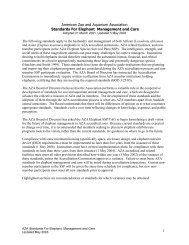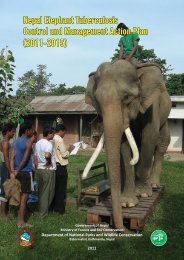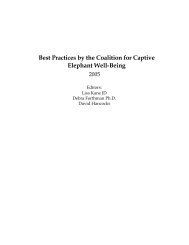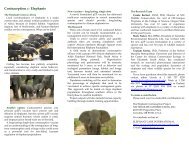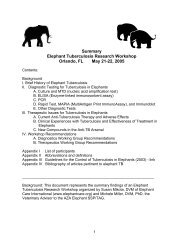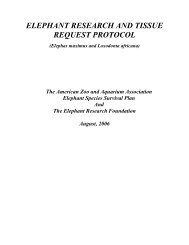Elephants Elephants - Wildpro - Twycross Zoo
Elephants Elephants - Wildpro - Twycross Zoo
Elephants Elephants - Wildpro - Twycross Zoo
- No tags were found...
You also want an ePaper? Increase the reach of your titles
YUMPU automatically turns print PDFs into web optimized ePapers that Google loves.
Seismic waveforms from vocalisations are detectable up to distances of 16 kmand up to 32 km for locomotion generated signals (e.g. foot stomp). Thiswould explain phenomena like a thunderstorm in Angola triggering elephantsin Namibia to move north and an elephant cull leaving a herd 50 km awaytense and agitated (Marchant 2001). Histology of the trunk-tip suggests that itis specialised to pick up vibrations and it is possible that elephants can alsopick up vibrations through the feet (Marchant 2001). However there is stillsome doubt as to the validity of these ideas although it remains a fascinatingpossibility (Langbauer 2000). Another possible communication channel is therecently discovered ear discharge from African elephants which may have afunction in olfactory communication (Riddle et al 2000).PLAYPlay in young includes head to head sparring and trunk wrestling, mounting,charging and rolling. Calves tend to play with others close to them in age andcalves over six months of age may form play-groups (Eisenberg and Lockhart1972). Females, particularly juveniles, frequently play with young calves.PREDATOR PROTECTIONAlthough adult elephants are immune from most predators (except humans)elephant calves are subject to predation from lions, tigers and hyenas.<strong>Elephants</strong> exhibit group defence against potential predators, with younganimals being protected by adults. The herd may form a cluster with adultsfacing the source of danger (Eisenberg and Lockhart 1972). Disturbedelephants may perform displacement behaviour in between threat displays.Cows with small calves are more likely to charge and calf distress isresponded to by the mother and other members of the family. Adolescent andjuvenile females play an important role in protecting calves; this has beenshown to be important in calf survival as mortality in the first 24 months ishigher in calves born into families with no allomothers (Lee 1987).TOOL USE<strong>Elephants</strong> exhibit tool use. In the wild this can range from using grass to rubon the body to scratching the body using a stick (Chevalier-Skolnikoff andLiska 1993). There are also reports of elephants using branches as fly switches(Hart and Hart 1994) and of modifying an unsuitable branch so that it becamea useful switch (Hart et al 2001a). This has been observed in both wild andcaptive animals. <strong>Elephants</strong> have been observed to use tools in variouscontexts which can be identified as: skin care, feeding and drinking, threatand aggression, rest and sleep and social interactions (Kurt and Hartl 1995)and types and variety in use increases with age.32




